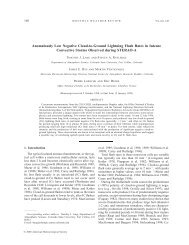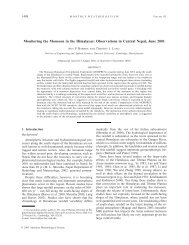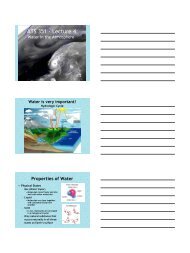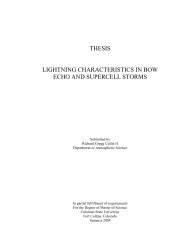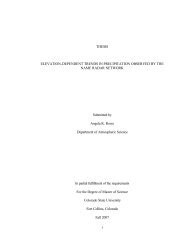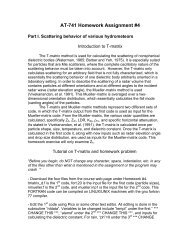1 A dual-polarization radar hydrometeor classification algorithm for ...
1 A dual-polarization radar hydrometeor classification algorithm for ...
1 A dual-polarization radar hydrometeor classification algorithm for ...
Create successful ePaper yourself
Turn your PDF publications into a flip-book with our unique Google optimized e-Paper software.
352353354355356357358359360361362363364365366367368369370371372373374<strong>algorithm</strong> could handle certain peculiarities and difficulties such as a slanted melting layer heightfrom WNW-SSE throughout the domain and non-uni<strong>for</strong>m precipitation.The complete <strong>classification</strong> <strong>algorithm</strong> includes three indivi<strong>dual</strong> HCAs with differentcategories that are used to in<strong>for</strong>m a final “fourth” <strong>classification</strong> based on melting layer detection.The four HCA steps completed <strong>for</strong> these polarimetric data are illustrated in Figure 5. First, the“melting layer detection HCA” in Fig. 5a distinguishes wet snow (WS) from the “other”category (OT), which represents aggregates and/or light rain. Melting layer <strong>classification</strong> onthese wet snow pixels with relatively high SNR (> 10 dB) is handled with the same generalmethodology presented by G8B1 to account <strong>for</strong> variable melting layer heights in each 10°azimuth sector of a PPI or <strong>for</strong> a single RHI. Following these previous studies, the melting layertop, median, and base are defined by the heights (AGL) below which 80%, 50%, and 20% of allwet snow gates reside in each sector. Only wet snow pixels between 5-35 km ranges are used todetermine the ML top, base, and median height to avoid non-uni<strong>for</strong>m beam filling errors(Ryzhkov et al. 2007), other sampling errors that degrade the quality of polarimetric variables atextremely close and far ranges, and regions where the beam substantially ascends with range.The ML base, median, and top altitude <strong>classification</strong>s from this particular range segment areapplied to the whole sector of the <strong>radar</strong>’s polar coordinate system. Then the wet snow pixels withsufficiently high SNR identified throughout the whole domain are officially used to denote themelting layer in future HCA steps.In order to detect precipitation transition events where the ML reaches the ground, MLheight was also allowed to vary with range along a single PPI azimuth or RHI. For both theazimuth- and range-dependent methodologies, wet snow pixels are interrogated at all verticallevels of the <strong>radar</strong> volume because ground clutter is presumably removed a priori. To this end,17



